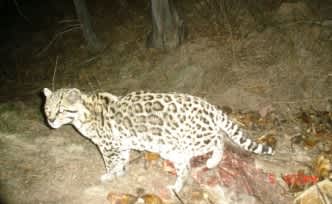Probable Ccelot Sighting in Arizona on Feb. 5
OutdoorHub 03.12.12

The Arizona Game and Fish Department announced today a highly probable, but not verifiable, sighting of a rare ocelot Feb. 5 in Arizona.
The sighting is documented in trail camera photos provided to the department by a third party and posted on the Internet site, www.coueswhitetail.com.
Analysis indicates that the ocelot is the same animal observed in February 2011 by Game and Fish officers and photographed by a hunter’s trail camera in May 2011 in the Huachuca Mountains. The new photos show the ocelot on what appears to be a deer kill. The trail camera is owned by a hunter who wishes to remain anonymous and has provided no additional details. At this time, the lack of location information will preclude it from being entered as a confirmed record in our Heritage Data Management System (HDMS) which tracks special status species records and is used to inform project planning and evaluation.
Nongame Branch Chief Eric Gardner said, “This sighting will be a Class I-10 report, which means that visual or physical evidence is provided and confirmed. We are confident it is an ocelot and have no reason to believe it was not photographed in Arizona, but without a more definite location it simply cannot be entered into our system in a meaningful way.”
Ocelots are small to medium-sized spotted cats with a long tail. These cats have been listed as endangered since 1982 under the federal Endangered Species Act. Since being listed, ocelots have only rarely been seen in Arizona. Only one other ocelot, an animal run over near Globe in April 2010, has been confirmed in Arizona since the mid-1960s. One other ocelot was reportedly captured on film in November of 2009; however, in a similar situation, the department has not been given the specific location of the photo and it has not been possible to fully verify the animal’s location based on that photo. The record is therefore not included in our state’s HDMS.
While the department agrees that both sets of photos from these sightings are of ocelots, without location and additional information, such as tracks, scat or hair analysis, recovered from the scene, they remain classified as “probable but not verifiable.” It is the department’s hope that additional information from either or both of these sightings would be brought forward to facilitate analysis and classification so that they could be included as an official record in the HDMS.
Ocelots tend to be smaller in size in the more northerly portions of their habitat range than those individuals in the central or southern habitat areas. The upper body coloring is highly variable, ranging from grayish to cinnamon or tawny to reddish brown. Dark markings form chainlike streaks down the sides of the ocelot’s body. They have a fairly long tail, as long as the body, and short rounded ears.
The present range for ocelots is in the eastern and western lowlands of Mexico, from southern Mexico through Central America and in the lowland areas of Colombia, Ecuador, Peru and Brazil. On the fringes of their range, they occupy a very limited region in both the United States (a remnant population exists in southern Texas) and Argentina. Other animals such as bobcats and young mountain lions are sometimes misidentified as ocelots, which is why verification is so very important.
Ocelots are protected by the Endangered Species Act and should be left alone. If anyone encounters a cat believed to be an ocelot, the Game and Fish Department requests that photos along with observation information be reported immediately to the department. A phone number for reporting is 1-800-352-0700.
For more information on ocelots, visit the department’s website at www.azgfd.gov/ocelot

